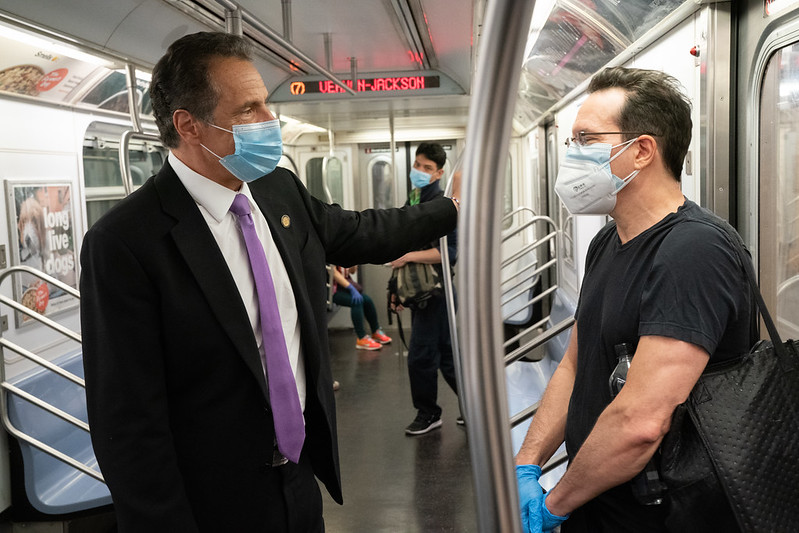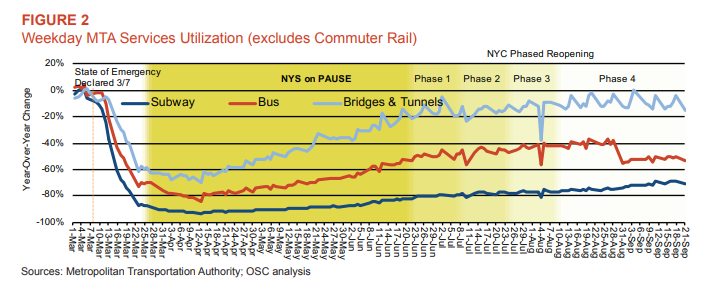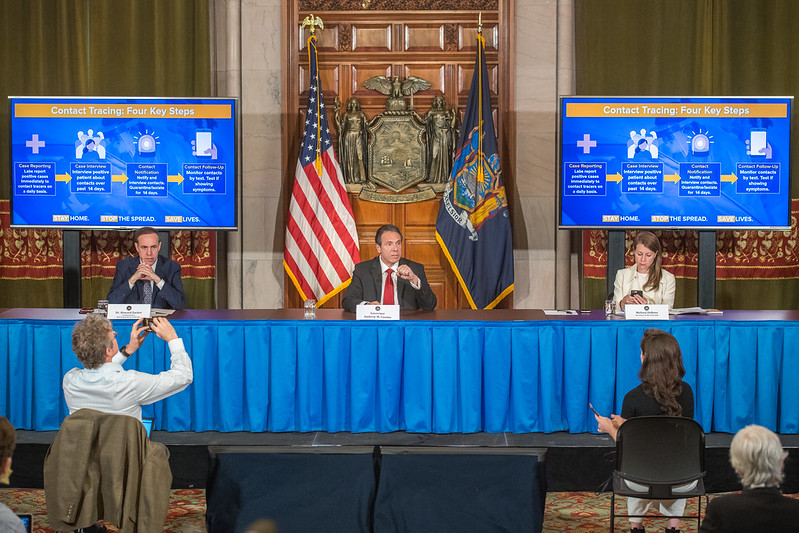The State Must Step In Now to Avoid a Mass Transit Apocalypse

Governor Cuomo on the subway (photo: governor's office)
Hope that Congress can enact a post-election stimulus package to aid the economy amid another explosion of coronavirus cases has narrowed. One major institution in New York, the Metropolitan Transportation Authority (MTA), is now out of time to get help. It is therefore necessary for New York State to step up and rescue the MTA before it begins a series of wrenching cutbacks that could permanently harm the New York region. The agency is being overwhelmed by financial losses due to the pandemic and its impact on the economy.
MTA Chair Patrick Foye, describing the MTA’s desperation, said in a NY1 interview on October 28, that “Our urgent request…to the United States Senate, is for $12 billion, which will take us through 2020…and 2021. That money is desperately needed. If we don’t receive it, our hand may be forced in terms of draconian service reductions, up to 40% on subways and buses, up to 50% on commuter rails, on top of laying off…thousands of our colleagues, plus fare and toll increases above those that are budgeted. This is an apocalyptic scenario.”
He went on to say that the MTA Board would make a decision at its December Board meeting to proceed with the cutbacks in the first quarter of 2021 if Congress didn’t give the MTA the money. He expressed optimism nonetheless.
An October 2020 New York State Comptroller report on the MTA presented the below graph showing the staggering ridership losses for the subways and other parts of the massive transit agency.

The graph shows subway ridership plunging 90% at the start of the pandemic, recovering to an 80% loss as the economy partially reopened by mid-June, and trending up to a still devastating 70% ridership loss from the beginning to mid-September. New York City Comptroller Scott Stringer has been tracking MTA ridership reports and other city economic matters and the most recent ridership numbers show losses are still 63-70% below weekday daily numbers from the year prior. The suburban commuter rail systems are faring badly too.
New York State adopted its 2020-2021 budget in April 2020, just weeks after the declaration of the national and New York COVID-19 emergencies. The state budget anticipated the economic plunge and authorized New York to cut its budget. It also authorized New York to borrow up to $11 billion short-term to adjust to potential massive cash flow problems, some of which stemmed from Congress postponing the April 15 income tax filing deadline to July 15. New York’s large borrowing authorization also permitted conversion of short-term loans into longer repayment periods, including 30-year bonds.
To date, New York State has borrowed $4.5 billion. Current plans are to repay $1 billion by December 31, and the remaining $3.5 billion by March 31, 2021 the end of the current fiscal year, according to the mid-year forecast issued by the State Division of the Budget. New York State is in possession of this cash now.
Governor Cuomo can ask the State Legislature to quickly appropriate this $3.5 billion in cash to the MTA. The state can convert the earlier short-term borrowing into 30-year bonds in the next several months. The state may be proceeding now to repay the other $1 billion and it would not be wise to interfere with any processes underway in relation to that repayment.
The State Comptroller’s Annual MTA Financial Report said the agency faces the greatest financial crisis in its history. The table below from that report shows that in 2020 the MTA has lost nearly $5 billion in fare and toll revenue, and nearly $2 billion in revenue from dedicated taxes and subsidies. Those $7 billion in losses were partially offset by the major federal stimulus package enacted in March, the CARES Act, which gave the MTA $4 billion. The MTA had a modest (a mere $412 million) deficit for 2020 before covid, but its final deficit for 2020 was projected in July to be $3.4 billion.
New York State appropriating $3.5 billion to the MTA now will stem this hemorrhaging for the moment and push the MTA’s crisis into later in 2021, though the MTA will need federal help sooner or later. State action now could help get the MTA to the Biden administration without catastrophe.

Even if the MTA gets the financial relief it needs for 2020, from New York State or the federal government, the table shows it faces a $6.2 billion deficit in 2021. If the economy fails to improve as much as anticipated, or if the huge part of New York City’s employment base now working home continues to do so, the MTA’s revenue losses would be higher and its deficits larger as a result. The MTA may be facing a major long-term restructuring.
The state budget allowed the MTA itself to borrow money, but it has said it simply cannot afford to do so. In fact, to survive into 2021 it must hoard cash. Among the options are deferring pension contributions, deferring Social Security payroll taxes, and halting cash contributions to the capital program. These options will save $3 billion in 2020-2021. The MTA can continue a hiring freeze and work with the labor unions on possible savings.
The 2020-2024 MTA capital program has been temporarily suspended. The centerpiece of revenue for that program, congestion pricing, was not approved by the Trump administration and awaits action from the Biden administration. It will be at least several years before most of this capital program can be started. The MTA will need to focus on finishing the 2015-19 capital plan with the remaining available sources of funds.
Severe health and economic problems other than the MTA confront New Yorkers. If the state is going to rescue the MTA, it could also borrow either short-term or long-term to avoid implementing its planned cutbacks to public services and aid to localities.
The State Division of the Budget’s plan to implement the adopted 2020-2021 budget provided for $8 billion in spending reductions in local assistance, in schools, health care, transportation, and emergency services. In its recently-released mid-year budget update, the Division of Budget reported that by the end of September it had withheld $2.4 billion in local aid, as it awaited the elusive new stimulus package that Congress and the President have failed to enact.
The Department of Budget’s April 25 Financial Plan indicated it would backload 40% of the state’s local assistance cutbacks to the final quarter of the state fiscal year, meaning from January through March 2021. That would represent a $3.2 billion cut to schools, hospitals, and other vital public services. If the state used $3.5 billion in borrowing authority to help the MTA, it could use part of the remaining borrowing authority to halt the cutbacks planned for the final quarter of the 2020-2021 fiscal year. This would mean the state would not be compounding the financial problems of local governments, including New York City, for now.
Sooner or later, Congress will pass another stimulus package that will include more aid for the unemployed, for state and local governments, and for transit agencies. It may be the President Biden stimulus package. But the MTA and New York’s local governments will be reeling by then if New York State does not act now. The state can use some of the funds from Congress to repay loans and cover deficits.
While such action is necessary, it will also remain true that the state, the city, the MTA, and the rest of New York’s local governments will likely confront the reality of continued budget deficits in 2021-2022, and beyond, and the necessity of a full-on restructuring of spending, borrowing, and taxing for years to come. But that likelihood does not negate the importance of state action now.
***
Jim Brennan was a member of the New York State Assembly for 32 years, where he chaired four committees. On Twitter @JimBrennanNY.
***
Have an op-ed idea or submission for Gotham Gazette? Email This email address is being protected from spambots. You need JavaScript enabled to view it.
Surveillance and the City: New York’s Latest Covid Boondoggle Is In Your Pocket

Gov. Cuomo talks contact tracing (photo: Darren McGee/Governor's Office)
With the presidential election behind us, I had started to gain hope that the robotexts of recent weeks would soon end. But on Friday night came a curious new entry to this genre of smartphone spam. It began, “Hi! This is the NYS Department of Health. Download the COVID Alert NY App!” With that message, I knew we had entered a new phase in the fight over contact tracing apps.
Contact tracing is nothing new. For decades, public health officials have tried to stymie the spread of contagious diseases by methodically mapping out anyone that patients might have infected. For human disease detectives, this means detailed and empathetic conversations with those who just were diagnosed with the potentially fatal COVID-19 virus, reconstructing any person they might have inadvertently infected, but also providing information on support services that range from food deliveries to city-funded dog walking.
Contact tracing is one of the most powerful tools we have, but contact tracing apps, the smartphone-enabled, Silicon Valley substitute, is a dangerous imitation. This is why it’s so upsetting to see New York spending so much time and money promoting a lackluster smartphone app rather than reinforcing the tools we know will work: social distancing, handwashing, masks, manual contact tracing, and (of course) high-speed, high-quality testing.
In recent days, COVID Alert NY has become inescapable on the web and social media, as a barrage of new ads try to get New Yorkers to download the app. And the result of this statewide push has been an abysmal failure.
New York officials are quick to brag that hundreds of thousands of users have downloaded the invasive new app. That’s just a tiny fraction of what is needed to make this app effective.
Researchers from Oxford University found we need 60%-80% of all New Yorkers to install this software for it to stop the pandemic. That’s 10-20 times the number of New Yorkers who have installed the application already. And the numbers may be worse. While New York reports the number of users who have tried out the app, they have been tighter-lipped about how many users actually use the software. A contact tracing app you don’t turn on does about as much good as wearing a mask but putting it on your forehead. A Google-funded study later found that 15% usage might reduce the spread of COVID-19. Unfortunately, the study has not yet been peer reviewed, and no state has enough public buy-in to test if these projections are accurate.
And it’s unclear if we could reach that magic 60%-80% cutoff even if we wanted. The majority of the world’s smartphones aren’t new or fast enough to run the contact tracing app. But, of course, Americans don’t trust the tech giants to take over public health tracking. According to the Pew Research Center, a majority of Americans don’t want to install this kind of app.
We’re at a crucial moment, when the second wave is spiking and we see our state on the verge of shutting down once again. This isn’t a time for magical thinking. This is the moment when we have to face the hard facts and make even harder decisions.
That means scrapping the dream that these apps will do the impossible, focusing instead on support for the basics, including manual contact tracing. It also means building trust with all New Yorkers, making sure that each and every COVID-19 patient feels safe providing their most intimate details to contact tracers.
These details aren’t just potentially embarrassing, for some New Yorkers this means putting their friends and family at risk of arrest or deportation. That’s in part because, months after it was passed by the state Legislature, Governor Cuomo has still yet to sign a bill (S. 8450-C/A. 10500-B) that would ban police and federal immigration enforcement (ICE) from accessing contact tracing data.
We don’t need a high-tech app to protect our city or state. We need to invest in evidence-based tools and fight for every single New Yorker to know that their contact tracing data is safe. This approach may not be as slick as a new app, but it has one thing going for it: it actually works.
***
Albert Fox Cahn (@FoxCahn) is the founder and executive director of the Surveillance Technology Oversight Project (S.T.O.P.) at the Urban Justice Center and a fellow at the Engelberg Center for Innovation Law & Policy at N.Y.U. School of Law. He writes the monthly “Surveillance and the City” column at Gotham Gazette. Caroline Magee is a rising third-year student at Emory University School of Law and a civil rights intern at the Surveillance Technology Oversight Project.
Note: this column has been updated to alter the presentation of the Oxford University study and add mention of the Google-funded study.
***
Have an op-ed idea or submission for Gotham Gazette? Email This email address is being protected from spambots. You need JavaScript enabled to view it.
Separating Fact and Fiction About the Special Flushing Waterfront District

Rendering of the Special Flushing Waterfront District
There are several myths and mischaracterizations about the Special Flushing Waterfront District (SFWD) that we as owners want to set the record straight about. Here are several key facts about the project.
SFWD does not provide an advantage to obtain building height.
The Federal Aviation Administration (FAA) and Port Authority of New York and New Jersey have already provided Letters of No Objection to allow height increases for the Special Flushing Waterfront District. SFWD only provides a consolidation of approval processes. Rather than submitting to the Board of Standards and Appeals for this, special permit approval would be provided by the City Planning Commission as part of the SFWD Waterfront Certification process. FAA and Port Authority Letters of No Objection have to be provided for this administrative approval.
In the past 20 years, the dozen special permits for height granted in Downtown Flushing were all routinely provided upon submission of FAA and Port Authority Letters of No Objection.
There will be zero sanitary sewer discharge into Flushing Creek.
All sanitary sewer effluent will be piped directly to Tallman Island Treatment Plant in College Point. Some say other developments pollute Flushing, making it seem like SFWD will do the same, but that is provably false.
SFWD provides comprehensive stormwater runoff mitigations to prevent shoreline erosion and provide prudent shoreline restoration techniques, such as: permeable pavers, green roofs, soft shoreline edges, and onsite stormwater retention before discharge into Flushing Creek.
As-of-Right vs SFWD: The exact same buildable bulk.
The as-of-right development scenario can currently be built. SFWD is not needed to achieve maximum bulk. At least two of the sites have plans that demonstrate this, one already with New York City Department of Buildings-approved building plans, ready to proceed. Opposition makes it appear this is not the case and that residential units, commercial and retail space are all being incrementally added.
Macedonia AME Church is not a victim.
The Macedonia AME Church was beneficially rezoned as part of the Municipal Lot #1 ULURP in 2010. That was an economic boost for them and they are an important stalwart in our community. Macedonia built 142 affordable housing units at their Macedonia Plaza site. We know Reverend Richard McEacheron and he voted for the Special Flushing Waterfront District as a member of Queens Community Board 7 and he testified in support of SFWD at the City Planning Commission and City Council hearings. There are no complaints from him or his congregation.
Community Support
At the recent City Council hearing, over 75% of the 100+ speakers were in favor of our project and its many merits. The Council also received more than 330 letters of support for the Special District from Flushing residents and business owners. The community clearly supports this project.
Queens Community Board 7 represents Flushing, among other neighborhoods. Minkwon Center may be vocal, but that does not make it the town crier for Flushing. Minkwon representatives have never appeared at any Queens CB7 hearings prior to the Special Flushing Waterfront District or since. It has its own agenda and refuses to meet with representatives of SFWD.
SFWD is not designed to provide a solution for homelessness nor ensure union jobs. It is designed to provide a better urban experience and numerous community benefits, including:
-A new road network, vital to our community, to alleviate College Point Boulevard traffic and connect the Special Flushing Waterfront District to Downtown Flushing.
-A fully public waterfront promenade doubled in width to 40 feet and extended by more than 400 feet in length.
-Space for seniors, youth groups and community organizations.
-6.6 acres of public open space, whereas as-of-right development would bring only 3 acres.
-Design that will allow for small local storefronts and better pedestrian experiences on the street and waterfront.
-An ideal public-private partnership between the Department of City Planning and three developers, designed to prevent the construction of three "Skyview" developments.
The current proposal seeks enhanced zoning for only 10% of the overall project on a small lot to the north, also entirely on private land. The vast majority of the project has no change in zoning at all, including the area encompassing the new public road network that will alleviate traffic and grant direct access to the waterfront. There is no increase in bulk, except a small portion in the north to allow a 400-foot extension of the waterfront promenade and to provide some affordable housing units.
If you want to advance more affordable housing, then you should contact the Mayor, the President of the New York City Economic Development Corporation (EDC), and City Council Member Francisco Moya. Insist on more affordable housing at Willets Point, which is public land.
A defeat of the SFWD does not advance the affordable housing issue. Defeat will remove affordable housing from the sites completely, and all the benefits described above.
***
by Richard Siu of F&T Group; William Xu of United Construction & Development Group; and John Liang, Young Nian Group.
***
Have an op-ed idea or submission for Gotham Gazette? Email This email address is being protected from spambots. You need JavaScript enabled to view it.




